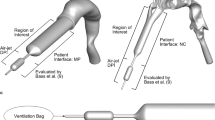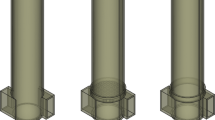Abstract
A jet nebulizer sprays a fine mist or aerosol directly into the lungs to reduce inflammation, expand airways, and make breathing easier for respiratory patients. Asthma, COPD, emphysema, and cystic fibrosis are treated with jet nebulizers. They are chosen over other nebulizers for their shorter treatment time and wider medication compatibility. For mechanically ventilated patients, jet nebulizers humidify oxygen to provide bronchodilators, antibiotics, and other respiratory medications. Additionally, they treat pneumonia, bronchitis, and other lung infections. Aerosol therapy requires medical jet nebulizers. However, experiment setup is time-consuming and challenging to enhance smaller droplet output. The study is aimed at enhancing the nebulizer and process parameters using numerical simulation and comparing the results to experimental data from the Malvern Spraytec™ laser diffraction system. This numerical model improves nebulization knowledge and predicts process parameters that affect output. Ansys Fluent was used to analyze a Creo-designed jet nebulizer solid model. The Spraytec™ experimental method was utilized to characterize fluticasone propionate’s aerosol output and build the best nebulizer. Laser diffraction and computational fluid dynamics (CFD) analysis measured the nebulizer aerosol output. Comparing particle size data between 2 and 5 μm. The results are similar, with a difference of 4.20%. Taguchi optimization found the optimal process parameter, and a conformation test enhanced the process parameter. The nebulizer generates 8.57% more fluticasone propionate at optimal particle size. The optimized nebulizer generates aerosols reliably and speeds up patient recovery.
















Similar content being viewed by others
References
Marieb E. Essentials of human anatomy and physiology. San Francisco, CA: Benjamin/Cummings Science Publishing; 1999. p. 393.
Armer, T. Opportunities for innovation in inhalation aerosols. Institute of Liquid Atomization and Spray Systems, Dearborn, MI. 2001.
Martonen TB, Zhang Z, Lessmann RC. Fluid dynamics of the human larynx and upper tracheobronchial airways. Aerosol Sci Technol. 1993;19:133–56. https://doi.org/10.1080/02786829308959627.
Corcoran TE, Dauber JH, Cigier N, Iacono AT. Improving drug delivery from medical nebulizers: the effects of increased nebulizer flow rate and reservoirs. J Aerosol Med. 2002;15(3):271–82. https://doi.org/10.1089/089426802760292618.
Vecellio L, Kippax P, Rouquette S, Diot P. Influence of realistic airflow rate on aerosol generation by nebulizers. Int J Pharm. 2009;371:99–105. https://doi.org/10.1016/j.ijpharm.2008.12.027.
Corcoran TE, Chigier N. Characterization of the laryngeal jet using phase Doppler interferometry. J Aerosol Med. 2000;13(2):125–37. https://doi.org/10.1089/089426800418659.
Corcoran TE, Chigier N. Inertial deposition effects: a study of aerosol mechanics in the trachea using laser Doppler velocimetry and fluorescent dye. J Biomech Eng. 2002;124:629–37. https://doi.org/10.1115/1.1516572.
Shen S-C, Wang Y-J, Chen Y-Y. Design and fabrication of medical micronebulizer. Sens Actuators, A .2008;144:135–143. https://doi.org/10.1016/j.sna.2007.12.004.
Jeng YR, Su CC, Feng GH, Peng YY. An investigation into a piezoelectrically actuated nebulizer with μEDM-made micronozzle array. Exp Therm Fluid Sci. 2007;31:1147–56. https://doi.org/10.3390/fluids5020091.
Su G, Longest PW, Pidaparti RM. A novelmicropump droplet generator for aerosol drug delivery: design simulations. Biomicrofluidics. 2010;4:044108–18. https://doi.org/10.1063/1.3517231.
Lai M Jr, Huang CY, Chen CH, Linliu K, Lin JD. Influence of liquid hydrophobicity and nozzle passage curvature onmicrofluidic dynamics in a drop ejection process. J Micromech Microeng. 2010;20:015–33. https://doi.org/10.1088/0960-1317/20/1/015033.
Fleming JS, Epps BP, Conway JH, Martonen TB. Comparison of SPECT aerosol deposition data with a human respiratory tract model. J Aerosol Med. 2006;19:268–78. https://doi.org/10.1089/jam.2006.19.268.
Coates AL, Allen PD, MacNeish CF, Ho SL, Lands LC. Effect of size and disease on estimated deposition of drugs administered using jet nebulization in children with cystic fibrosis. Chest. 2001;119:1123–30. https://doi.org/10.1378/CHEST.119.4.1123.
Asgharian B, Hofmann W, Bergmann R. Particle deposition in a multiple path model of the human lung. Aerosol Sci Technol. 2001;34:332–9. https://doi.org/10.1080/02786820151092478.
ICRP (International Commission for Radiological Protection). Human respiratory tract model for radiological protection. Pergamon Press, Oxford, UK. 1994;66.
Freijer JI, Cassee FR, Subramaniam R, Asghararian B, Anjilvel S, Miller FJ, van Bree L, Rombout PJA. Multiple path particle deposition model (MPP Dep version 1.11). A model for human and rat airway particle deposition. RIVM Report 650010019. National Institute for Public Health and the Environment (RIVM). Chemical Industry Institute of Toxicology (CIIT). Bithoven, The Netherlands. 1999.
Jarvis NS, Birchall A, James AC, Bailey MR, Dorrian M-F. LUDEP 2.0 personal computer program for calculating internal doses using the ICRP publication 66 respiratory tract model. National Radiological Protection Board, Chilton, UK. 1996.
Ho SL, Kwong WT, O’Drowsky L, Coates AL. Evaluation of four breath enhanced nebulizers for home use. J Aerosol Med. 2001;14:467–75. https://doi.org/10.1089/08942680152744677.
Katz SL, Ho SL, Coates AL. Nebulizer choice for inhaled colistin treatment in cystic fibrosis. Chest. 2001;19:250–5. https://doi.org/10.1378/chest.119.1.250.
Leung K, Louca E, Munson K, Dutzar B, Anklesaria P, Coates AL. Calculating. 2007. https://doi.org/10.1128/JVI.00346-10.
Leung K, Louca E, Coates AL. Comparison of breath-enhanced to breath-actuated nebulizers for rate, consistency, and efficiency. Chest. 2004;126:1619–27. https://doi.org/10.1378/chest.126.5.1619.
Gemci T, Shortall B, Allen GM, Corcoran TE, Chigier N. A CFD study of the throat during aerosol drug delivery using heliox and air. J Aerosol Sci. 2003;34:1175–92. https://doi.org/10.1016/S0021-8502(03)00094-6.
Coates AL, MacNeish CF, Lands LC, Meisner D, Kelemen S, Vadas EB. A comparison of the availability of tobramycin for inhalation from vented vs. unvented nebulizers. Chest. 1998;113:951–6. https://doi.org/10.1378/chest.113.4.951.
Wong W, Fletcher DF, Traini D, Chan H-K, Young PM. The use of computational approaches in inhaler development. Adv Drug Deliv Rev. 2012;64(4):312–22. https://doi.org/10.1016/j.addr.2011.10.004.
Gebhart J, Heicwer G, Heyder J, Roth C, Stahlhofen W. The use of light scattering photometry in aerosol medicine. J Aerosol Med. 1988;2:89–112. https://doi.org/10.1089/jam.1988.1.89.
Clark AR, Chambers CB, Muir D, Newhouse MT, Paboojian S, Schuler C. The effect of biphasic inhalation profiles on the deposition and clearance of coarse bolus aerosols. J Aerosol Med. 2007;20:75–82. https://doi.org/10.1089/jam.2006.0557.
Darquenne C, Brand P, Heyder J, Paiva M. Aerosol dispersion in human lung: comparison between numerical simulations and experiments for bolus tests. J Appl Physiol. 1997;83:966–74. https://doi.org/10.1152/jappl.1997.83.3.966.
Kim CS, Hu SC, DeWitt P, Gerrity TR. Assessment of regional deposition of inhaled particles in human lungs by serial bolus delivery method. J Appl Physiol. 1996;81:2203–13. https://doi.org/10.1152/jappl.1996.81.5.2203.
Kim CS, Hu SC. Total respiratory tract deposition of fine micro meter-sized particles in healthy adults: empirical equations for sex and breathing pattern. J Appl Physiol. 2006;101:401–12. https://doi.org/10.1152/japplphysiol.00026.2006.
Menter F. Zonal two equation kw turbulence models for aerodynamic flows. In 23rd fluid dynamics, plasmadynamics, and lasers conference.1993; 2906. https://doi.org/10.2514/6.1993-2906.
Zhang R, Cong T, Tian W, Qiu S, Su G. Effects of turbulence models on forced convection subcooled boiling in vertical pipe. Ann Nucl Energy. 2015;80:293–302. https://doi.org/10.1016/j.anucene.2015.01.039.
Arto Voutilainen, Statistical inversion methods for the reconstruction of aerosol size distributions, 2001;67–94. https://doi.org/10.1080/174159701088027753.
Carvalho TC, McConville JT. The function and performance of aqueous aerosol devices for inhalation therapy. J Pharm Pharmacol. 2016;68(5):556–78. https://doi.org/10.1111/jphp.12541.
Steven M. Donn., Sunil K. Sinha. Manual of neonatal respiratory care. 3rd Edition, Springer.2012.
William Wong A, David F. Fletcher B, Daniela Traini A, Hak-Kim Chan A, Paul M. Young A. The use of computational approaches in inhaler development. Advanced Drug Delivery Reviews. 2012;64:312–322. https://doi.org/10.1016/j.addr.2011.10.004.
Muers M. Overview of nebulizer treatment. Thorax. 1997;25:255–305. https://doi.org/10.1136/thx.52.2008.s25.
European Respiratory Society Guidelines on the use of nebulizers. Eur Respir J.2001; 18:228–42. https://doi.org/10.1183/09031936.01.00220001.
Respironics® Clinician’s Guide I-neb adaptive aerosol delivery (AAD) system for target inhalation mode (TIM) and tidal breathing mode (TBM). Respironics®.
Lefebvre AH, McDonell VG. Atomization and sprays. 2017: CRC press.
Taguchi G. System of experimental design: engineering methods to optimize quality and minimize costs, UNIPUB/Kraus International Publications, 1987.
Montgomery DC. Design and analysis of experiments-second edition. Qual Reliab Eng Int. 1987;3:212–212. https://doi.org/10.1002/qre.4680030319.
Carman P, Tigwell P. CATIA reference guide, 2nd. revised. US: On Word Press; 1998.
Practical aspects of finite element simulation: a study guide, 3rd ed., Academic Program, Altair University, ALTAIR Hyper Works 11.0.
CFX: computational fluid dynamics, Ansys, HVAC, Nuadha Trev,International Book Market Service Limited, 2012.
Allen TT. Software overview and methods review: Minitab. London: In Introduction to engineering statistics and lean six sigma. Springer; 2019. p. 575–600.
Minitab,. Statistical software, Version 16. State College: Minitab Incorporation; 2016.
Malvern-Instruments, Spraytec User Manual MAN0368. 2017, Issue.
Malvern/INSITEC, Method for measuring particle size in the presence of multiple scattering. 1997, Google Patents: US.
Pui DY, Romay-Novas F, Liu BY. Experimental study of particle deposition in bends of circular cross section. Aerosol Sci Technol. 1987;3:301–15.
Nekahi A, Dehghani K. Modeling the thermomechanical effects on baking behavior of low carbon steels using response surface methodology. Mater Des. 2010;31:3845–51. https://doi.org/10.1016/j.msea.2010.07.088.
Moradi M, Ghoreishi M, Frostevarg J, Kaplan AF. An investigation on stability of laser hybrid arc welding. Opt Lasers Eng. 2013;4:481–7. https://doi.org/10.1016/j.optlaseng.2012.10.016.
Moradi M, Ghoreishi M, Torkamany M. Modelling and optimization of nd: Yag laser and tungsten inert gas (TIG) hybrid welding of stainless steel. Lasers in Engineering (Old City Publishing). 2017;96:1–6. https://doi.org/10.1016/j.optlaseng.2017.04.004.
Kuo Y-M, Chan W-H, Lin C-W, Huang S-H, Chen C-C. "haracterization of vibrating mesh aerosol generators. Aerosol and Air Quality Research.2019.
Vecellio L. Influence of realistic airflow rate on aerosol generation by nebulizers. International Journal of Pharmaceutics, 2009;04–17. https://doi.org/10.1016/j.ijpharm.2008.12.027.
Author information
Authors and Affiliations
Contributions
N. Vinoth: methodology, conceptualization, data curation, experimentation, simulation, original draft preparation, writing, and editing.
Lokavarapu Bhaskara Rao: conceptualization, validation, investigation, simulation and visualization, supervision, reviewing, and editing.
Corresponding author
Ethics declarations
Conflict of Interest
The authors declare no competing interests.
Additional information
Publisher's Note
Springer Nature remains neutral with regard to jurisdictional claims in published maps and institutional affiliations.
Rights and permissions
Springer Nature or its licensor (e.g. a society or other partner) holds exclusive rights to this article under a publishing agreement with the author(s) or other rightsholder(s); author self-archiving of the accepted manuscript version of this article is solely governed by the terms of such publishing agreement and applicable law.
About this article
Cite this article
N, V., Lokavarapu, B. Enhanced Optimal Parameter-Based Nebulizer Design for Flow Analysis of Fluticasone Propionate. AAPS PharmSciTech 24, 85 (2023). https://doi.org/10.1208/s12249-023-02548-1
Received:
Accepted:
Published:
DOI: https://doi.org/10.1208/s12249-023-02548-1




